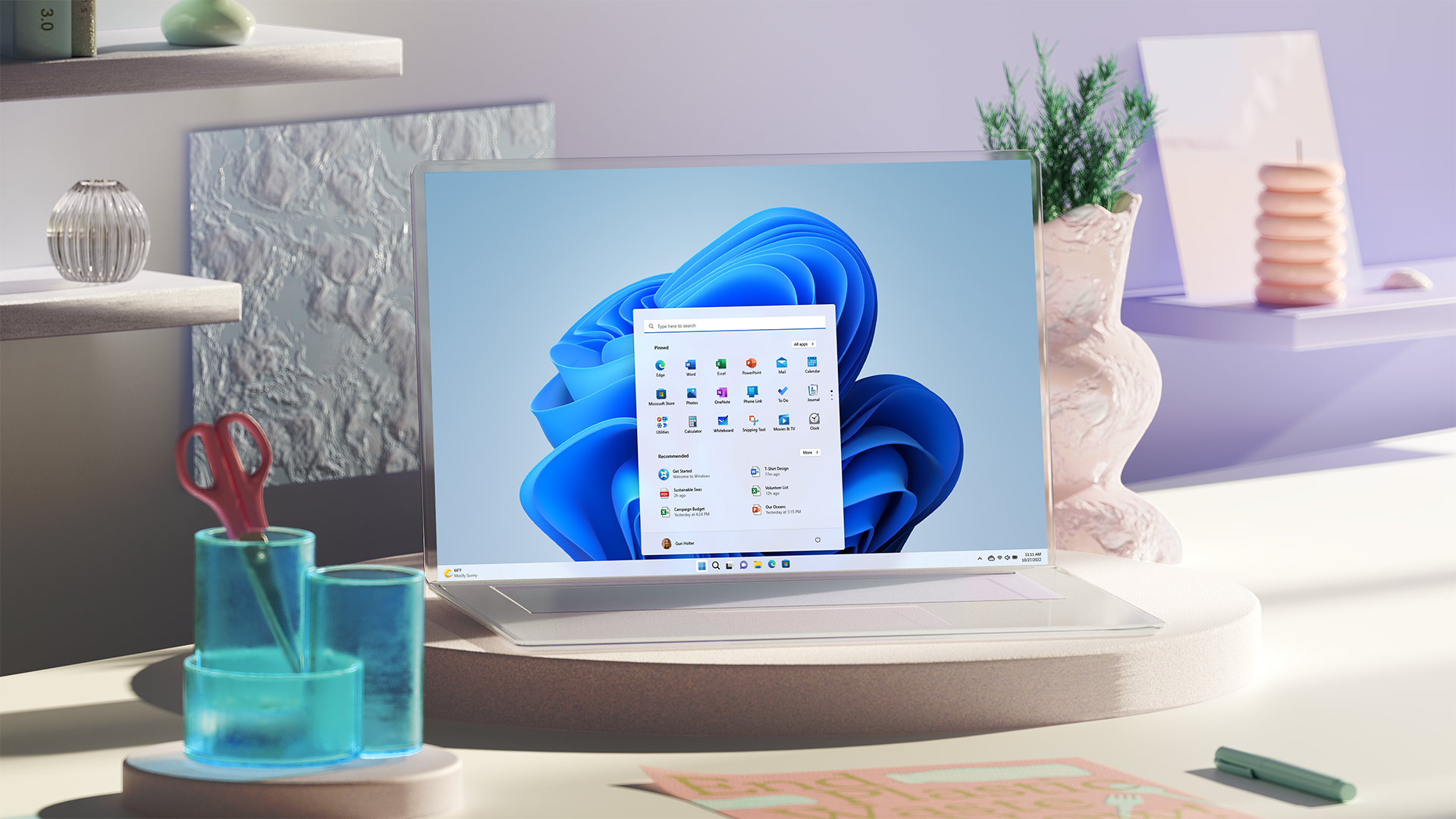What kind of 2022 did Microsoft experience? The company made some big moves during the course of this year, including a gargantuan near-$70 billion acquisition – mired in controversy – and it also brought the first major feature update to Windows 11. Let’s take a deep dive into how Microsoft fared across the software, hardware, and gaming fronts over the past year.
Windows 11’s big update (and bugged updates)
Windows 11 is still relatively new, having arrived late in 2021, and the biggest thing to happen to the OS this year was the debut of its first major update. (Remember that there’ll only be one feature update per year now, rather than twice yearly as was the case in the past). The Windows 11 2022 Update (informally known as 22H2) pitched up in September, applying a whole lot of polish, alongside some major and useful changes to the interface. We were also treated to a new system of ‘Moments’, fancy Microsoft jargon for smaller updates more agilely applied as needed outside of the big yearly feature upgrade.
Some of the notable improvements piped through included the introduction of tabs for File Explorer, allowing for multiple folders to be opened in one File Explorer window, in the same way there are multiple tabs in a browser. That represented the delivery of a long-promised feature from Microsoft. The taskbar also received a lot of attention, with a taskbar overflow panel being brought in, and after lots of clamoring from a good many Windows 11 users, drag-and-drop functionality was finally returned to the taskbar.

Indeed, it seems that something of a theme for the year was Microsoft listening more to feedback and user needs, as another much complained about aspect of the taskbar – the removal of the option to ungroup apps on the bar, a piece of functionality that’s in Windows 10 – looks set to be remedied. Or at least that facility has been present in testing with Windows 11, and should be here soon, fingers crossed, for those who don’t want multiple instances of the same app combined on the taskbar.
The feeling that Windows 11 is a work in progress still remained, with Microsoft needing to do a good deal of honing and revamping to knock various bits of the interface into better shape (and clear up cluttered legacy corners of the UI) – plus frustrating bugs were still a problem.
Throughout 2022, while there weren’t any show-stoppers in the way of Windows 11 bugs (as has been seen with Windows 10 in the past), we’ve reported on far too many glitches, and some nasty enough ones. Like printers having much of their functionality stripped away, for example, as well as gremlins that dragged down performance levels in various ways, and gamers came under fire from some seriously annoying bugs, too. Flaws in File Explorer seemed particularly rife, as well, which is a concern given that this is the core pillar of the UI (the very files and folders you work with every day).

Perhaps the real acid test we can use to measure the success of Windows 11 in 2022 is looking at how many people made the move to the OS (or bought a new PC with it installed, of course). According to Statcounter’s figures (as of November 2022, the latest available at the time of writing), 16% of all Windows users are on Windows 11. That’s not great for an operating system which has been out for over a year now, especially considering Windows 7 holds almost a 10% share of the market. A completely outdated OS is not far behind, in other words.
Furthermore, a year into its reign as the cutting-edge operating system for Microsoft, Windows 10 had secured almost 30% adoption, nearly twice as much as Windows 11 has managed. Although that said, Windows 11 is hampered somewhat because some people can’t upgrade, as their PC doesn’t meet the more stringent requirements (particularly on the security front), so Microsoft will have expected migration to be slower when they baked those elements into the design of the OS.
Overall, Windows 11 made reasonable headway in applying important interface changes, for sure, but we’d like to see more progress still, and especially a better effort in combating bugs, with an overhaul long overdue for Microsoft’s QA processes in our opinion.

Surface so-so
Just like any other year, another bunch of refreshed Surface devices emerged.
In June we got our first glimpse of the Surface Laptop Go 2, which wasn’t hugely different to the original laptop, but made some useful improvements, and remains a great choice for a compact notebook.
Then in October, at a big Microsoft event we witnessed the revelation of the Surface Pro 9 and Surface Laptop 5, alongside the Surface Studio 2+.
This wasn’t the best crop of Surface hardware for Microsoft, sadly. For starters, the Surface Laptop 5 failed to wow us, turning out to be spectacularly middle-of-the-road. Not terrible, but hampered by performance issues, and definitely not worth the hefty asking price pinned to the laptop.
The Surface Pro 9 turned out to be a better device, for sure, taking some laudable steps forward from the Pro 8. It also made an interesting move in having two flavors: a 5G model with a Qualcomm SQ3 (ARM) CPU, and a version with an Intel processor, the former being a great option for some (businesspeople on the move, for instance), albeit with ARM-related gremlins in the works. The Pro 9 remained pricey, but an undeniably slick device overall, and a good upgrade from its predecessor in the performance stakes.
The Surface Studio 2+ received just a minor upgrade, as the 2+ (rather than a 3) denoted, but Microsoft implemented some solid changes, albeit nothing particularly exciting. Which about sums up what happened on the Surface front overall: nothing bad, by any means – certainly not with the Surface Pro 9 – but nothing great, either.

Game for an acquisition
In January, Microsoft pounced to buy gaming giant Activision Blizzard in a huge acquisition for close to $70 billion. Yes, that Activision – the one with franchises like Call of Duty, Diablo, Overwatch, World of Warcraft and many other big-name games in its stable.
The magnitude of this deal can’t be underestimated, meaning that in the future, Xbox Game Pass owners could get the next Call of Duty blockbuster for nothing as part of that subscription (whereas PlayStation fans will have to stump up cash, and we’re all very familiar with the eye-watering cost of games these days).
Indeed, the ripples from this deal are still ongoing now, because at the time of writing this piece, the Federal Trade Commission (FTC) has filed a lawsuit to block Microsoft’s acquisition on the grounds that it could suppress rivals to the Xbox console.
Naturally, Microsoft has given us a whole raft of assurances on how it won’t throw its weight around in anti-competitive fashion after snapping up Activision, but there are plenty of doubters, and the FTC points to Microsoft’s past history and the ZeniMax (Bethesda) acquisition. While in that case, promises were also made about not withholding games from rival consoles, the FTC observes that post-acquisition, titles like Starfield, Redfall, and Elder Scrolls 6 were made Xbox exclusives.
Microsoft’s Activision buyout could still come a cropper at the final hurdles, then, potentially.

Ads nauseum – but with a glimmer of something positive?
While you might expect to see ads in a web browser, you don’t in your operating system. Because, you know, you paid good money for that OS, in the case of Windows anyway (or good money for the machine it came on, and that was part of the bill).
But ads taking up real-estate in Windows menus or panels again became a worry in 2022, as Microsoft tested – and note, these were just experiments that didn’t come to the release version of Windows 11 – adverts for OneDrive in the user session (shutdown) menu. And even more galling, the company briefly flirted with ads in File Explorer too, that central pillar of the Windows interface. That those waters were even tested is a concern, really.
All this could make you think that adverts are going to be a thorn in the side of Windows 11 users in the future – especially given Microsoft’s past form, this is not a new thing, of course – but instead, another possibility emerged late in the year.
Namely the notion that Microsoft could be angling towards low-cost PCs which are sold on subscription, rely on cloud services, and are supported by ads (to make them cheaper – so there’d be a benefit in this case). This was just a rumor, picked up (in November) via a Microsoft job listing, but earlier in July of this year, Microsoft CEO Satya Nadella talked about incorporating ads in its products.
There were clearly heard groans at this prospect, but as we observed, in a cost-of-living crisis, where not everyone might be able to afford a new PC, this could be a good thing to make Windows computers more accessible to those struggling with money.

Head in the clouds
Speaking of cloud services tied in with those ad-supported cheap PCs, this is an area where Microsoft went from strength to strength during 2022. Cloud revenue was strong right from the start of the year, and then in October, Microsoft’s Q1 2023 fiscal results showed that while the Windows division faltered – and was down 15%, in fact, partly due to the slump in PC sales this year – cloud revenue was buoyed by 24% compared to the same quarter in 2021.
Microsoft made $25.7 billion in just one quarter – over half its total revenue for that period – if you had any doubt about where the future lies for swelling the software giant’s coffers.
Concluding thoughts
With the PC slump, it wasn’t the best year for Microsoft – but cloud revenue was a clear highlight, and going by those various experiments with advertising in Windows 11, the company may have future plans to stoke profits in a different way, with low-cost ad-supported systems.
2022 was a pretty run-of-the-mill year for Surface hardware, albeit with some solid upgrades for some devices. And Windows 11 was a similar case of some reasonable progress being made, in the main, albeit with thorny asides in the form of bugs. However, a highlight with Windows 11 was seeing Microsoft listen more to user feedback, although arguably, some of the introductions made based on popular demand should have been addressed more swiftly.
That mammoth Activision Blizzard acquisition very much remains something to watch, as it’ll have potentially huge ramifications for the gaming industry next year if it goes through; but it feels like there’s still a distinct possibility of it coming off the rails.
from TechRadar - All the latest technology news https://ift.tt/7Nfwg2C
No comments:
Post a Comment